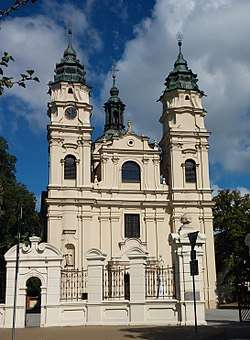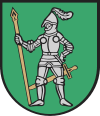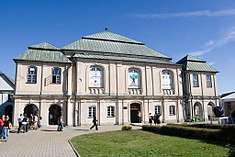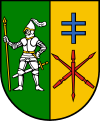Włodawa
Włodawa pronounced [vwɔˈdava] (Yiddish: וולאָדאַווע Vlodave, Ukrainian: Володава Volodava) is a town in eastern Poland on the Bug River, close to the borders with Belarus and Ukraine. It is the seat of Włodawa County, situated in the Lublin Voivodeship since 1999. As of 2011 it has a population of 14,800.
Włodawa | |
|---|---|
 Baroque Saint Louis church in Włodawa | |
 Flag  Coat of arms | |
 Włodawa | |
| Coordinates: 51°33′N 23°33′E | |
| Country | |
| Voivodeship | Lublin |
| County | Włodawa County |
| Gmina | Włodawa (urban gmina) |
| Town rights | 1534 |
| Government | |
| • Mayor | Wiesław Muszyński |
| Area | |
| • Total | 17.97 km2 (6.94 sq mi) |
| Population (30.06.2016) | |
| • Total | 13,535 |
| • Density | 750/km2 (2,000/sq mi) |
| Time zone | UTC+1 (CET) |
| • Summer (DST) | UTC+2 (CEST) |
| Postal code | 22-200 |
| Car plates | LWL |
| Website | Official website |
Geography
The town lies along the borders of Poland with both, westernmost Belarus and Ukraine, on the banks of the Bug River, 51 kilometres (32 miles) from Chełm in Poland and Brest in Belarus; 64 kilometres (40 miles) from Terespol, 86 kilometres (53 miles) from Lublin, and 77 kilometres (48 miles) from Liuboml in the Volyn Oblast of Ukraine. It is close to the Belarusian southernmost strip of the Brest Raion within the Brest Region bordering with north-western Ukraine.
History
Włodawa was first mentioned in historical records in 1242. The first written mention of the town in an Old Slavonic chronicle which speaks about Prince Daniel staying there, escaping from the Tartars in 1241. In 1446-1447 the surrounding territories were annexed into the Grand Duchy of Lithuania and the river Włodawka marked the border between the Duchy and the Polish Crown within the Polish–Lithuanian Union. In 1475 Michał and Aleksander Sanguszko received the town in exchange with the Polish King Casimir IV Jagiellon. For the next 100 years the town became the home for the Sanguszko family. They built their castle here and developed the town's prosperity. The Sanguszko profited from the border crossing which was bringing good income. In 1534 the town received city rights, confirmed in 1540. At that time the influx of the Jewish population started, which promoted commerce and crafts.[1] The location on the large river, Bug, favored the rapid development of the city as a commercial and transit center.
By the end of the 16th century, Włodawa passed into the hands of Andrzej Leszczyński and from that time belonged to the Leszczyński family for next generations.[2] As Leszczyński was a Calvinist, Włodawa soon became an important center of Protestantism. In 1624 a Calvinist church and a school were built here.[3] Between 1633 and 1648, the minister of the Calvinist congregation in Włodawa was Polish historian and poet Andrzej Węgierski.[3] In 1634 a Calvinist synod was held in Włodawa, which was attended by delegates from the entire Polish–Lithuanian Commonwealth.[3] Protestants from Bohemia, Moravia and Silesia also settled in Włodawa at that time.[2]
.jpg)
In 1648, the Cossack-Tatar army plundered and destroyed the city, killing almost the entire population, including all Jews.[2] In 1657 the city was devastated again, this time by the Swedes during the Deluge.[2] John III Sobieski and the subsequent Polish kings granted the right to four annual fairs.[3] Horses and, above all, oxen from nearby Volhynia were sold at these fairs, with the latter being even sold to Kraków, Poznań, Berlin and Vienna.[3] These fairs, as well as the staple right for salt contributed to Włodawa's wealth.[3] In the 17th century, Rafał Leszczyński, father of the future Polish King Stanisław Leszczyński, became the owner of Włodawa, but due to debts he sold it to Ludwik Pociej.[2] Pociej brought the Paulines from the Jasna Góra Monastery in Częstochowa to Włodawa and built their monastery.[2] In the 18th century, the city was the property of the Pociej, Flemming, Czartoryski and Zamoyski families.[2]
After the Partitions of Poland, Włodawa was annexed by Austria in 1795.[3] In 1809, it briefly returned to Polish rule, being part of the Duchy of Warsaw.[3] In 1815 it became part of Congress Poland, initially autonomous, but later forcibly integrated within Imperial Russia. The inhabitants of Włodawa actively joined the January Uprising in 1863.[3] After the fall of the uprising, bloody repressions began and the attempts at Russification intensified.[3] During World War I, from 1915 to 1918, the city was occupied by the Germans.[3]
Following Poland's return to independence, Włodawa became a seat of the Włodawa County. In 1939, before the onset of World War II, the population of Włodawa was 9,293.[3] There was a garrison of heavy artillery regiment and the division of the field artillery in the town, used by the Pomorze and the Modlin armies in the defence of Poland against Nazi Germany and the Soviet Union. Włodawa was bombed by the Luftwaffe on 3 September 1939.[3]
Ethnic Minorities
Jewish community

The existence of a Jewish community in Włodawa is first recorded in connection with the Lublin fair of 1531. By 1623 Włodawa had a representative in the Council of the Four Lands. The community's prosperity was due to the granting of a city charter in 1534. For much of the early modern period, a time when the Polish-speaking community of the region was predominately engaged in agriculture, Jews appear to have composed much of the population of the city, engaged in all forms of craft production and trade. The community was devastated by the Chmielnicki massacres of 1648,[4] but afterwards re-established and rebuilt. By 1765 the town had 630 Jews. In 1693, the town had 197 dwellings, 89 owned by Jewish families. The census of 1773 records Jewish physicians, butchers, millers, barbers, goldsmiths, tailors, furriers, merchants, and carters, in addition to one Jew in each of the trades of coppersmith, cobbler, glazier, chandler, and wheelwright. There were also 8 schoolmasters, 2 educators, a cantor, a bass player and a cymbal player.[5] There were 2,236 Jews in 1827 and 6,706 in 1907.
In the late 19th century Włodawa had a Jewish-owned steam-powered flour mill, tannery and soap factory. Of the 184 stores in the town, 177 were owned by Jews. Włodawa's first Zionist organization was formed in 1898, the town also had Bund, Agudath Israel and Poalei Zion organizations. There was a Beis Yaakov school for girls also.[6]
.jpg)
Włodawa was over 70% Jewish before the Nazi-Soviet invasion of Poland and the Holocaust.[3] The city became part of the Nazi German Lublin District of the General Government following the invasion. Włodawa Ghetto was set up by the German administration in 1941.[1] Jews from all neighbouring locations were sent there. The Ghetto was overcrowded and lacked food and medicine. Starvation and disease were common. Round ups for the Holocaust transports to the nearby Sobibór extermination camp took place in waves: 1,300 Jews in May 1942, 5,400 in October, 2,800 in November 1942, and 2,000 in April 1943, as well as the last 150 in May 1943. In June, all remaining Jewish children under the age of 10 were deported and gassed. During the ghetto liquidation action, at the end of October 1942 hundreds of Jews escaped to the surrounding forests. Włodawa Jews were mostly deported Sobibór, but some were executed locally at the German Arbeitslager workcamps such as the one at Adampol. Several Jews from Adampol and the Włodawa Ghetto were able to escape, and joined the Parczew partisans in the forests, fighting actively against the Nazis with Soviet assistance and weapons. The Jewish cemetery was demolished by the Germans who used the headstones as road building material, and turned the Synagogue into military storage.[7]
On the road to Włodawa there is a memorial to the Jews from Włodawa who were killed at Adampol. No Jews are known to live in the town today, although the handsome, Baroque, Wlodawa Synagogue serves as major tourist attraction. A Włodawa landsmenschafte (society) was founded in America for survivors and descendants of Włodawa's Jewish Community and has members scattered throughout the US, Canada, Australia, England, Israel and elsewhere. London had a Wlodawa Synagogue (London).
Amish Community
In the 1700s, while some Amish families traveled west from Germany and Switzerland in their quest for religious freedom in Pennsylvania, others would venture to Central and Eastern Europe. In 1781, the Austrian emperor Joseph II invited German farmers to move to Galicia, after seizing the region (which today lies in southeastern Poland and Western Ukraine) in the First Partition of Poland.[8] Other Amish however settled the area of Włodawa, which was then still part of the Polish–Lithuanian Commonwealth (see Nolt, A History of the Amish, p. 64-65).
Points of interest
There are several monuments and tourist attractions worth seeing in Włodawa:
- Saint Louis church and baroque monastery, founded by Pauline Monks in the 18th century. The interior is decorated by illusionistic monumental paintings (1784-1785) created mainly by painter Gabriel Sławiński.[9]
- Czworobok, built in the 18th century in the shape of a rectangle. It was used by merchants to sell their goods.
- Wlodawa Synagogue of 1764, that is currently used to host exhibitions about Włodawa Jews as well as local folklore.
- Russian Orthodox church, erected in 1840-1843 and rebuilt in Russian Revival style in 1893[10] and is used by local Polish Autocephalous Orthodox Church community.[11]
- Włodawa State Museum (Polish: Muzeum Pojezierza Łęczyńsko-Włodawskiego), managing the Sobibór Museum nearby until April 2011
References
- Virtual Shtetl. "Jewish history of Włodawa" (in Polish). POLIN Museum of the History of Polish Jews. Olszewski E., Szczygieł R. (1991), Dzieje Włodawy, Lublin – Włodawa.
Akcję likwidacji getta zakończono na przełomie kwietnia i maja 1943 r.
- "Historia miasta". Polesie24.pl (in Polish). Retrieved 8 October 2019.
- "History of Włodawa" (in Polish). Nasza.Wlodawa.pl official website. 2007. Archived from the original on 2007-01-28 – via Internet Archive.
Miasto liczy w 1939 r. 9293 mieszkańców.
- Squaring of the Circle: Polish-Jewish Relations Through the Ages : the Story of an Unrequited Love, By Arnon Rubin, by Tel Aviv University Press, 2005, p. 10
- The complex of Synagogue Buildings in Wlodawa, Malgorzata Podlewska-Bem, Leczynsko-Wlodawskie Lakeland Museum, Wlodawa
- Encyclopedia of Jewish Life Before and During the Holocaust, Shmuel Spector, NYU Press, 2001, Vol 3, p. 1452
- Resource Guides. "Remember Jewish Wlodawa". With maps and dozens of family photographs. Genealogy Group. Retrieved 3 June 2015.
- "Five Unexpected Places Amish Once Lived".
- Ludera, Magdalena. Gabriel Sławiński – późnobarokowy malarz w służbie Kościoła i Cerkwi (= Prace Muzeum Narodowego w Krakowie, vol. 6), Kraków 2016. pp. 149–173. ISBN 978-83-7581- 234 -3.
- G. J. Pelica: Ślady zapomnianego piękna. Włodawa i okolice. Włodawa: Parafia Narodzenia Przenajświętszej Bogarodzicy we Włodawie, 2009, p. 5-10. ISBN 83-85368-31-0.
- „Kalendarz prawosławny 2012”, p. 244, 2011. Warszawa: Warszawska Metropolia Prawosławna. ISSN 1425-2171.
External links
| Wikimedia Commons has media related to Włodawa. |
- History of Włodawa. Nasza.Wlodawa.pl 2oo7, official website, via Internet Archive. (in Polish)
- Virtual tour of Włodawa (in Polish)
- Remember Jewish Włodawa (in English)
